The Old Mill of Guilford, in Oak Ridge, North Carolina
A couple of weeks ago, I took a pleasant drive to a part of North Carolina that I don’t normally visit. The Old Mill of Guilford, in Oak Ridge, is a working mill an hour and a half northeast of Charlotte. It has the distinction of being one of the oldest operating gristmills in America. The mill is located at 1340 Hwy 68 North, a few miles northwest of Greensboro.
History
Before We Were The United States
Let that sink in. Before we were The United States!
After moving from Hopewell, Virginia, in 1753, Daniel Dillon settled in this area, then part of Rowan County. In 1755, a tract of 552 acres of land was surveyed for Dillon, and, in 1759, was granted to him by the Earl of Granville. On January 10, 1764, according to Rowan County records, Dillon obtained a license to build a public gristmill, to grind grain for area farmers, near the mouth of Beaver Creek.
In 1771, this area became part of Guilford County.
The American Revolution
British Successes
During the American Revolutionary War (1775-1783), it is believed that the mill was seized by British General Charles Cornwallis, in February of 1781. Cornwallis saw earlier successes against General George Washington’s Continental Army in New Jersey, in 1776.
But, by June, 1778, the French had entered the war, in support of the Americans. So Cornwallis shifted his campaigns to the South, hoping to enlist American colonists still loyal to Great Britain and the Crown. He thought that taking the South first would make it easier to win in the North.
Cornwallis’ forces defeated American troops in several battles in the South, including the ports of Savannah, Georgia (December, 1778), and Charleston, South Carolina (May, 1780). He also fought Major General Horatio Gates at the Battle of Camden, South Carolina (August, 1780), strengthening the British hold on the South.
After Gates lost Camden, Washington replaced him with Major General Nathanael Greene to lead the Continental Army in the South.
The Tide Turns
Cornwallis’ exhausted army soon met with stronger opposition as they marched toward North Carolina. A turnaround began on October 7, 1780, when the Patriot militia defeated the Loyalists at King’s Mountain, near the border between North Carolina and South Carolina. Patriot troops surrounded and surprised British Major Patrick Ferguson’s 1200 men. Ferguson was killed after an hour’s fighting, and the Patriots claimed victory. Among the 900 Patriots was Davy Crockett’s father, John Crockett.
Greene divided his troops to force Cornwallis to battle on multiple fronts. Brigadier General Daniel Morgan defeated British forces led by Colonel Banastre Tarleton at Cowpens, South Carolina, on January 17, 1781. Cornwallis pushed into North Carolina and engaged in heavy recruiting to expand his forces. Greene was in Virginia doing likewise, before returning to North Carolina.
On March 14, 1781, Greene and his troops camped near Guilford Court House. This location is near present-day Greensboro, which later was named for General Greene. The next day, the Battle of the Guilford Court House lasted less than two hours, pitting Cornwallis’ 1900 soldiers against Greene’s 4400 troops and militia. Both sides suffered losses before Greene’s forces retreated. Cornwallis lost one fourth of his troops in that short period of time.
After decisive losses at King’s Mountain and Cowpens, and this Pyrrhic victory at Guilford Court House, Cornwallis abandoned the British campaign for the South. He and his army proceeded to Wilmington, North Carolina, to rebuild his forces. Greene moved into South Carolina, achieving a dissolution of the British hold on the South, later in 1781.
Surrounded
Cornwallis led his troops to the Virginia coast, hoping to receive backing from British General Henry Clinton’s large army in New York City, and ended up in Yorktown, in southeastern Virginia. He raided every farm he came across, stealing horses and freeing thousands of slaves, winning allegiance from many of them. General Cornwallis fortified the town, and waited for help.
In the meantime, Washington asked the Marquis de Lafayette to block Cornwallis’ escape. George Washington’s troops and the French, under Comte de Rochambeau in New York and Comte de Grasse’s fleet offshore, surrounded Cornwallis’ army. After a three-week siege, this battle effectively signaled the end of the American Revolution.
And Surrendered
After 5 years of General Cornwallis’ participation in the war, he surrendered his 8,000 British soldiers and seamen to the French and American forces at Yorktown, on October 19, 1781. He did not attend the surrender ceremony, perhaps due to illness, but sent his second-in-command, General Charles O’Hara. O’Hara presented Cornwallis’ sword to the American and French commanders.
Peace negotiations commenced in 1782, and the Treaty of Paris was signed on September 3, 1783. The United States of America now was formally recognized by Great Britain as a free and independent nation.
The Mill
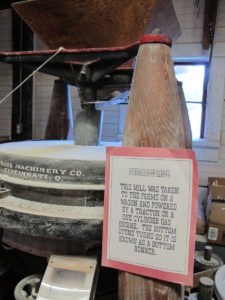 Daniel Dillon’s estate, through Nathan Dillon, executor, sold the tub mill, a house, and 175 acres on Beaver Creek to Joel Sanders (also seen as Saunders) in 1808 for $900. Records indicate that Sanders owned two other mills on Deep River, in Guilford County. Sanders moved the mill 500′ downstream; the original mill now sits in the mill pond.
Daniel Dillon’s estate, through Nathan Dillon, executor, sold the tub mill, a house, and 175 acres on Beaver Creek to Joel Sanders (also seen as Saunders) in 1808 for $900. Records indicate that Sanders owned two other mills on Deep River, in Guilford County. Sanders moved the mill 500′ downstream; the original mill now sits in the mill pond.
Through the early 1800’s, the mill changed hands from the Dillon family to the Sanders family. In 1869, R.A. Blalock, for $2250, purchased a half interest in the mill and 197.25 acres. James A. Sanders and his wife, Ella, sold the other half of the mill and 197.25 acres, in 1872, to John M. Brittain for $2500. In 1875, Brittain bought Blalock’s interest for $2350.
Ownership of the mill continued under the R.M. Stafford family, and then the Johnsons, then the Baynes and Lowry (Lowery) families, the Cudes and the Beesons.
In 1912, British buttons and musket parts reportedly were found on the site when the dam washed away. The next year, in 1913, K.L. Hendrix (Hendricks) bought the mill. Undocumented information indicates that the mill was converted to a roller mill, replacing the less durable wooden water wheels.
Around 1928, a metal pipe was installed under the road, replacing the canal from the dam. The mill changed ownership a few times over the next quarter century, from the Hendrix family to the Staffords, and back again.
In 1954, Clarence E. Bailes and McLeod Leather Belting Co. purchased the roller mill, a power plant, and 122 acres. They replaced the roller mill machinery and the turbine with a 24′ x 4′ Fitz overshot water wheel.
Bailes made other improvements to the operation to comply with agricultural regulations, added the sales office, and built the feed mill next to the original mill. Lloyd Lucas became miller and operated the mill until his death in 1975, when the mill closed.
In Modern Times
 Charles Parnell purchased the mill in 1977, renovated it, and restored its 200-year-old tradition as a water powered gristmill. He and his wife, Heidi, developed many new products, which gained national recognition for quality.
Charles Parnell purchased the mill in 1977, renovated it, and restored its 200-year-old tradition as a water powered gristmill. He and his wife, Heidi, developed many new products, which gained national recognition for quality.
Annie Laura Perdue spent years training as a miller under Mr. Parnell. When both of the Parnells died in 2007, she took over as miller.
The mill currently is powered by electricity, as the metal pipe that carries water from the mill pond needs to be replaced. Although the mill has experienced many changes over the centuries, some original parts, including structural timbers, still remain in the building.
In 2008, Amy and Darrell Klug bought The Old Mill of Guilford. Annie Laura continues to this day as miller, with help from community volunteers. The Old Mill of Guilford brochure, compiled by Jack L. Perdue, concludes with this succinct missive: “The Klugs continue to introduce new products, maintain the historical integrity of the mill, and enhance the mill’s reputation for high quality, natural stone ground products.”
Products
The Old Mill of Guilford’s website lists many locations in North Carolina where their products are sold. (Yes, they can ship them to you!) And, of course, you’re welcome to purchase directly from the mill store. It’s open every day from 9 a.m. to 5 p.m. You can find outlets carrying the mill’s flours and mixes in other states, as well, including Virginia, California, South Dakota, and Texas.
This is a privately owned operation, so your patronage is kindly appreciated.
Think: Gifts! Stocking stuffers! Must warm up the oven once in a while!
- The Mill Store.
- Locally made jams, jellies, and other items.
- Wheat and one of the old timbers.
- A grindstone and the feed mill.
The Mill Store has grits and flours of all kinds (including rye), steel cut oats, gingerbread mix, lemon poppyseed and sweet potato biscuit mixes. Buttermilk and apple cinnamon pancake mixes, corn meal, cookie and scone mixes. But there’s so much more! The store, conveniently located right next to the gristmill, offers 50 or so all natural ground products, with no preservatives. You’ll also find local jams and honey, bean soup mixes, locally made crafts, and even a jigsaw puzzle featuring The Old Mill of Guilford.
Annie Laura and volunteer Carola were there to answer all my questions, as they packaged and labeled the mill’s products.
The Old Mill of Guilford is listed in the National Register of Historic Places. It would be a great day trip with the kids, a camera, or an easel and canvas. Since semi-retiring, I love finding places like this.
Today, it’s so easy to put bread on the table, but imagine how complicated it was 200 years ago. And who doesn’t miss the smell of freshly baked bread or muffins? With cold weather about to make its debut in the coming days, this is a great time to bake something. Mmmm…gingerbread!
Phone: (336) 643-4783, Amy and Darrell Klug.
Email: info@oldmillofguilford.com.
Website: www.oldmillofguilford.com.
Address: 1340 Hwy 68 N, Oak Ridge, NC 27310.
An article about another gristmill can be found here: Mabry Mill On The Blue Ridge Parkway, in Meadows of Dan, Virginia. It’s part of the National Park Service.
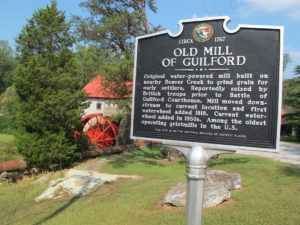
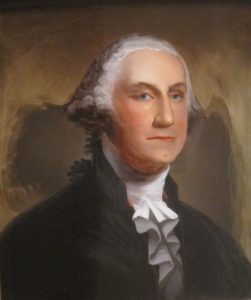
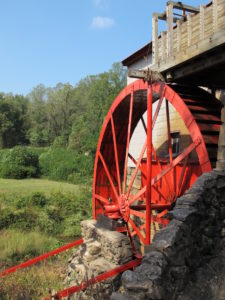
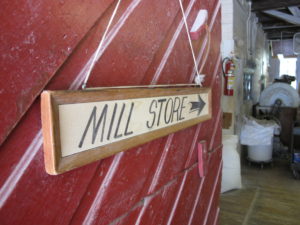
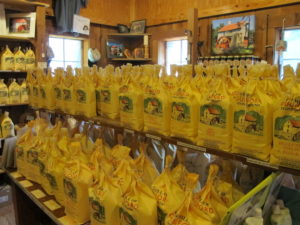
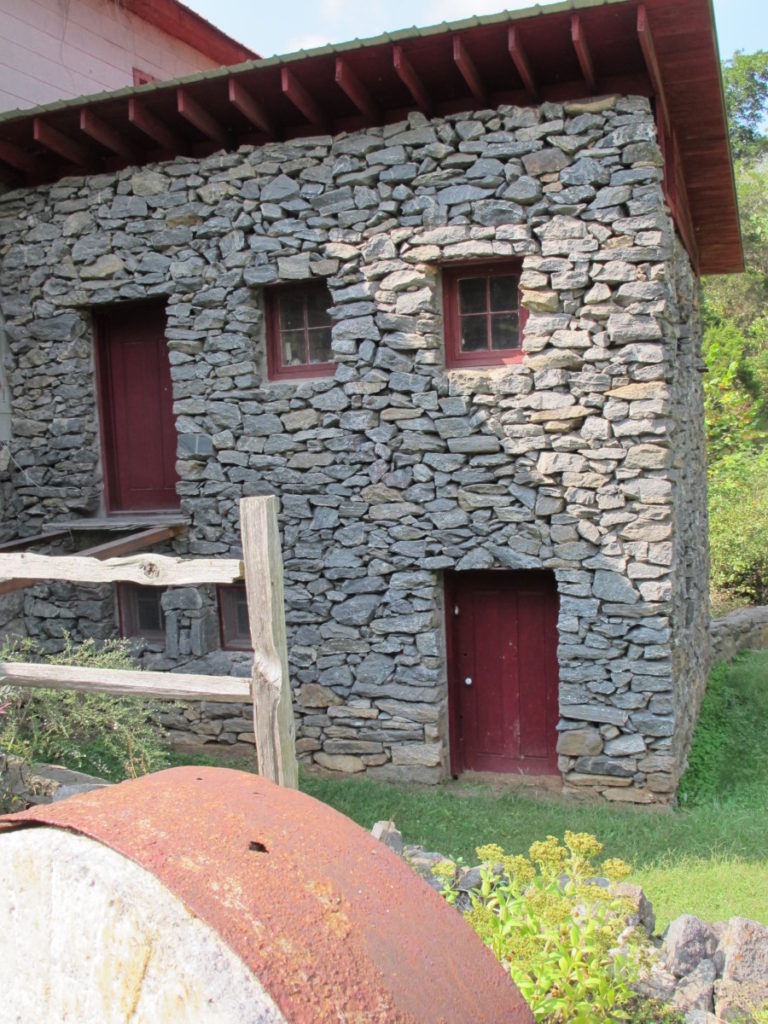
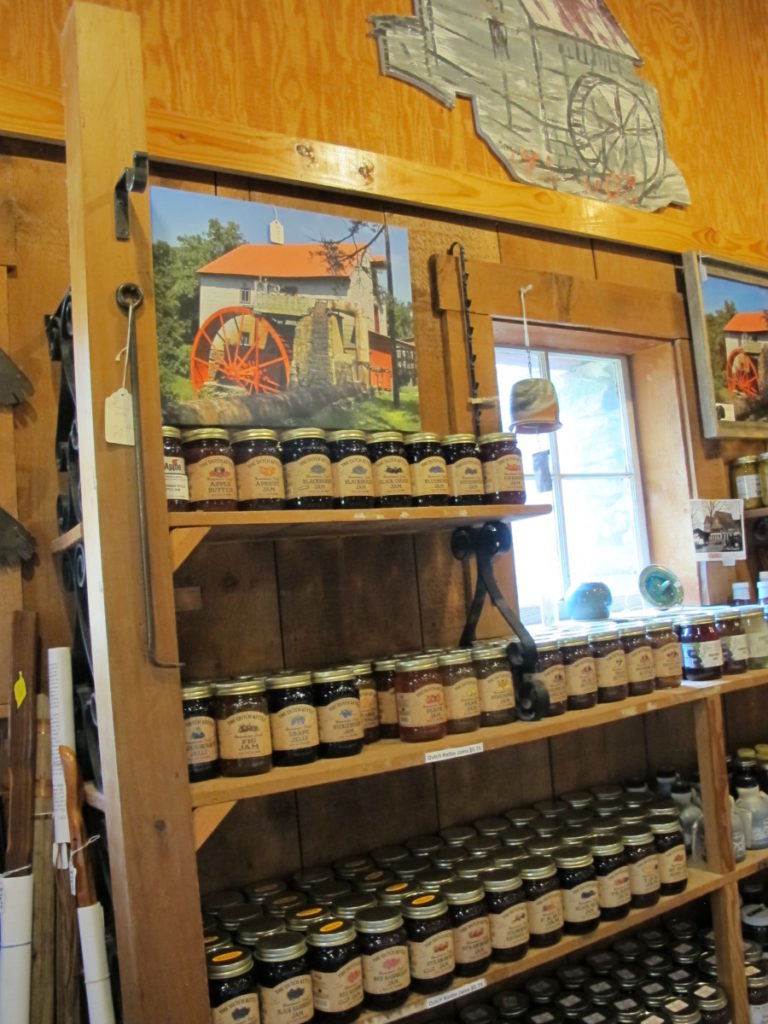
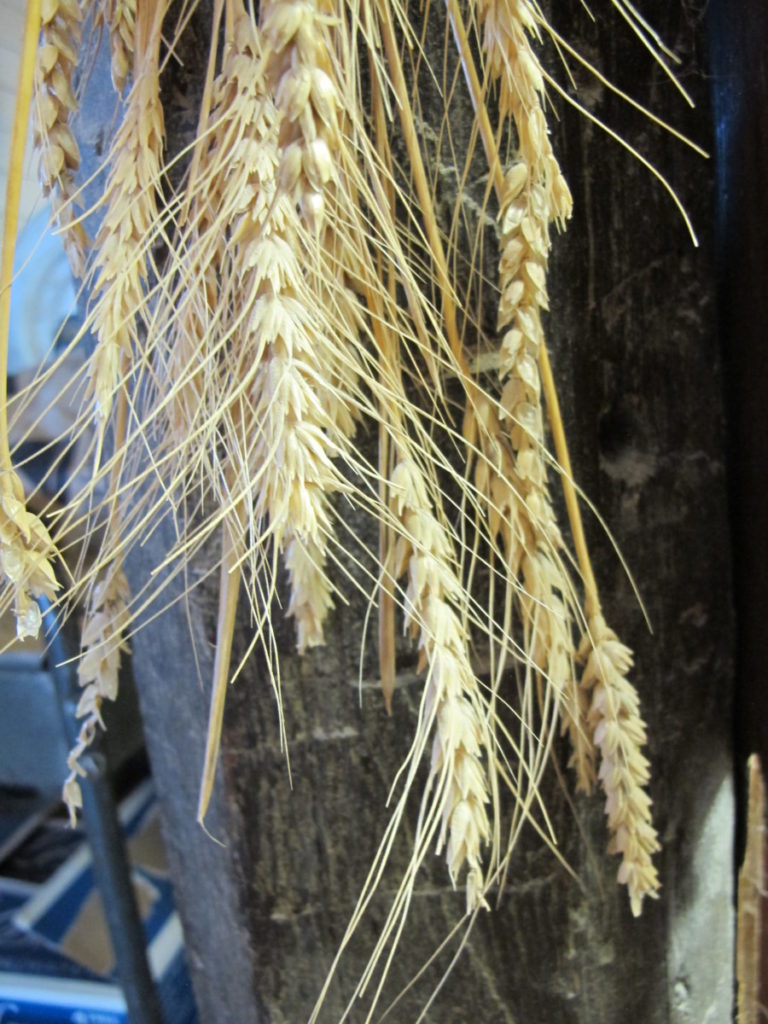
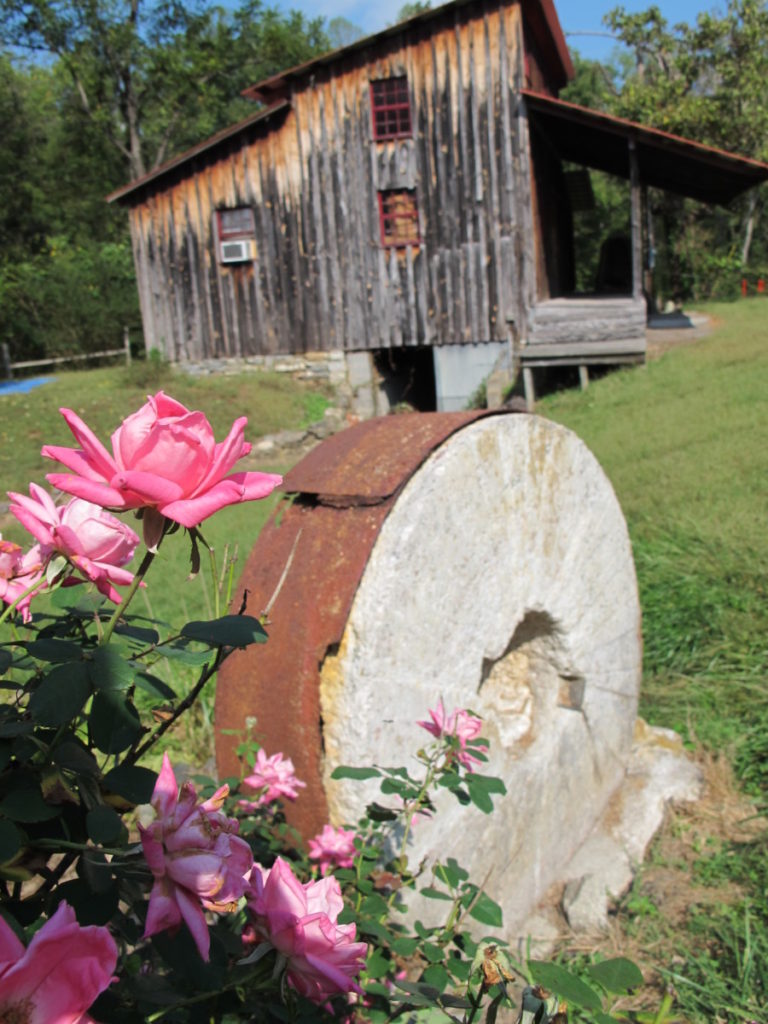

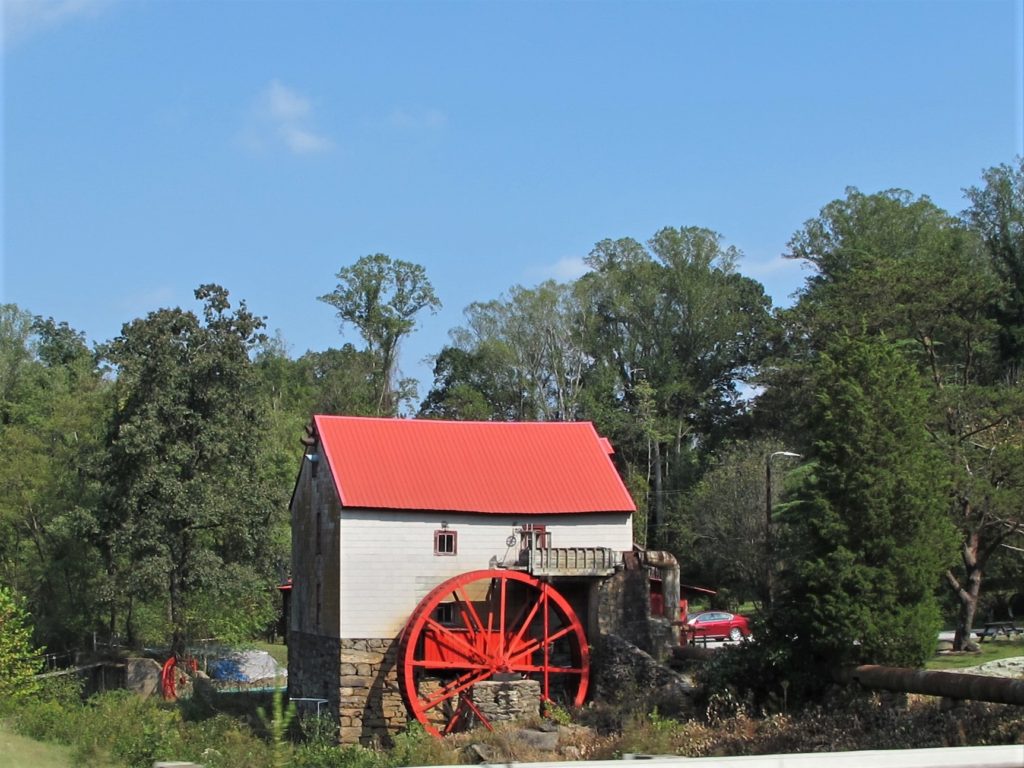
Hi Dr. Bailes–
Thank you for your comment. Yes, Annie Laura and Carola were very generous with information about The Mill. I will make another trip in the future (need more of that wonderful gingerbread mix). How exciting for you, to have been able to live the history!
Be well,
Kim
GREAT ARTICLE
MY DAD, CLARENCE EDWARD BAILES, WAS THE OWNER FROM 1954 -1977.
MANY FOND MEMORIES FROM WORKING THERE IN THE SUMMERS WHEN SCHOOL WAS OUT.
JUST GLAD TO SEE THESE GOOD LADIES ARE CARRYING ON AND KEEPING THE OLD MILL RUNNING. IT WAS AND IS GREAT TO HAVE BEEN A PART OF THAT HISTORY .
JAMES OSCAR BAILES, M.D.